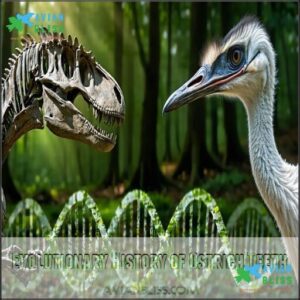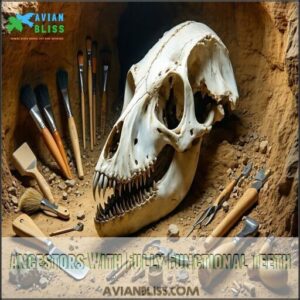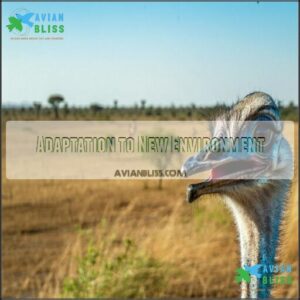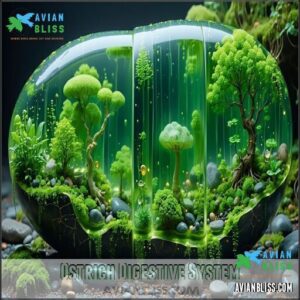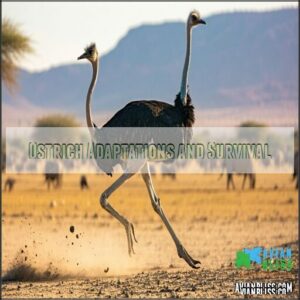This site is supported by our readers. We may earn a commission, at no cost to you, if you purchase through links.
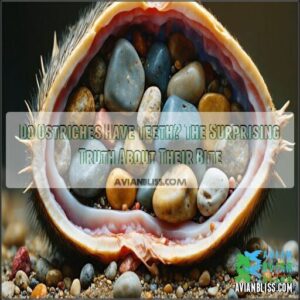
Like all birds, ostriches rely on their beaks rather than teeth to grab and manipulate food.
Instead of grinding food with teeth, they’ve got a clever digestive trick: they swallow small rocks, called gastroliths, to help break food down in their gizzard (a muscular part of their stomach).
It’s an impressive adaptation for such large, flightless creatures.
Notably, their distant ancestors had teeth, but evolution ditched them in favor of speed and efficiency. Who needs teeth when you’ve got a powerful beak and a stomach full of pebbles?
Table Of Contents
- Key Takeaways
- Ostrich Teeth Existence
- Ostrich Dental Structure
- Ostrich Evolutionary History
- Ostrich Digestive System
- Unique Features of Ostrich Beaks
- Ostrich Diet and Nutrition
- Ostrich Physical Characteristics
- Ostrich Adaptations and Survival
- Ostrich Behavior and Ecology
- Conservation and Farming
- Frequently Asked Questions (FAQs)
- Conclusion
Key Takeaways
- Ostriches don’t have teeth; instead, they swallow small stones, called gastroliths, which help grind food in their gizzard.
- Their ancestors had teeth, but evolution replaced them with strong beaks and efficient digestive systems.
- Ostriches briefly develop tiny, non-functional tooth buds as embryos, hinting at their toothy prehistoric lineage.
- They rely on their beaks for grabbing food and their gizzard stones for breaking it down into digestible nutrients.
Ostrich Teeth Existence
You might be surprised to learn that ostriches don’t have teeth, but their story doesn’t end there.
Traces of their ancient lineage and genetic quirks reveal fascinating clues about why these birds lost their pearly whites.
Vestigial Teeth in Ostriches
Believe it or not, ostriches don’t have teeth, but they do offer a glimpse into their evolutionary past through embryonic tooth buds. These genetic remnants form during development but never fully grow.
Ostriches may lack teeth, but their embryonic tooth buds reveal a fascinating genetic link to their prehistoric, toothy ancestors.
Here’s the fascinating breakdown:
- Ostrich embryos briefly develop 10-12 tiny tooth structures.
- These buds show evolutionary regression, a classic atavism example.
- Their presence points to ancient dental development genes, linking ostrich anatomy to the evolution of birds.
Link to Reptilian Lineage
Ostriches are like living fossils, offering a glimpse into their reptilian ancestry and the fascinating evolution of birds.
Their connection to ancient archosaurs—the group that includes dinosaurs and crocodiles—unveils traits linking them to a time when birds had teeth.
Though modern ostriches are toothless, embryonic stages reveal tiny, non-functional teeth, hinting at avian dentition from their evolutionary timeline.
These vestigial structures are like genetic echoes of their past.
Here’s what ties ostriches to their prehistoric relatives:
- Genetic evidence connects ostriches to toothy ancestors.
- Fossil records show bird teeth evolution from dinosaurs.
- Skeletal similarities link ostriches to ancient archosaurs.
- Embryonic enamel traces suggest birds with teeth once thrived.
Ostriches truly bridge the gap between dinosaurs and today’s toothless birds.
Genetic Factors in Tooth Development
Genetic mutations and shifts in regulatory genes explain tooth loss in toothless birds like ostriches.
Their genome sequencing reveals vestigial genes tied to avian dentition, hinting at ancestors like Archaeopteryx, a bird with teeth.
Gene expression once directed enamel formation, but evolution favored beaks over teeth.
These changes highlight bird teeth evolution, replacing teeth with specialized beaks and digestive systems.
| Feature | Ancestors | Modern Ostriches |
|---|---|---|
| Teeth | Present | Absent |
| Gene Expression | Enamel Formation | Beak Development |
| Digestive Mechanism | Limited | Advanced (Gizzard Use) |
Ostrich Dental Structure
You might think ostriches have teeth hidden somewhere, but they don’t—at least not functional ones.
Instead, their beaks and unique digestive system handle the work teeth usually do, with some evolutionary quirks adding to the story.
Non-Functional Teeth
You might think ostriches skipped the teeth department entirely, but they’ve got a secret: vestigial structures. These genetic remnants hint at their evolutionary past.
During development, tiny tooth-like structures appear but vanish before hatching—a quirky nod to their ancestors.
Here’s the scoop:
- These atavism examples connect ostriches to prehistoric creatures like Archaeopteryx.
- Evolutionary loss of teeth led to their powerful ostrich beak with serrated edges for gripping food.
- Toothless beaks are better suited for their diet, proving nature’s knack for efficiency.
Enamel on Vestigial Teeth
Even though ostriches don’t have teeth, their vestigial development during embryonic stages briefly includes enamel formation, hinting at their evolutionary significance.
This genetic expression connects their past to their present beak-adapted lifestyle. Modern birds experienced genetic mutations that led to tooth loss.
Curious how birds evolved? Let’s compare:
| Feature | Teeth | Beak |
|---|---|---|
| Material | Enamel Composition | Keratin |
| Function | Chewing | Grasping, tearing |
| Evolutionary Role | Early vertebrate feeding | Bird anatomy focus |
| Current Use | None (vestigial) | Essential for diet |
Who needs teeth when your beak’s a multitool?
Evolutionary History of Ostrich Teeth
The tale of ostrich teeth traces back to their evolutionary roots.
Long ago, their ancestors had fully functional teeth, but changes in diet and jaw morphology led to tooth loss.
Over time, their specialized ostrich beak and powerful gizzard took over food processing.
Here’s the Tooth Loss Timeline:
- Ancestral Diets: Early birds relied on teeth for diverse diets.
- Beak Evolution: Strong beaks replaced teeth for food manipulation.
- Genetic Atavism: Embryonic teeth became vestigial.
- Modern-Day Birds: Teeth vanished, leaving efficient adaptations.
This journey highlights evolution’s knack for innovation!
Ostrich Evolutionary History
You might be surprised to learn that ostriches once had ancestors with fully functional teeth.
Over millions of years, their diet and environment shaped them into the toothless, beak-equipped birds you see today.
Ancestors With Fully Functional Teeth
Fossil evidence reveals that ancient ostriches weren’t always toothless.
Their ancestors, linked to dinosaurs, sported fully functional teeth, a feature tied to now-dormant tooth development genes.
Early bird dentition played a vital role in ancient ostrich diets, helping process both plants and prey.
Over time, evolution favored beak adaptations for efficiency, leading to evolutionary tooth loss.
This shift, shaped by changing diets and environments, answers the curious question: do birds have teeth?
Not anymore—just powerful beaks!
The result is a testament to how species adapt to their surroundings, ultimately leading to the loss of certain traits, such as teeth, in favor of more efficient solutions.
Dietary Changes and Loss of Teeth
When you think about ostriches and their diet, teeth don’t come into the picture.
That’s because dietary adaptation over time led to tooth reduction, making way for a more efficient beak and gizzard evolution.
Instead of chewing, ostriches rely on a clever system to break down food.
Here’s how they manage without teeth:
- Beak morphology: Their strong, flat beak grips and tears vegetation like roots and grasses.
- Stone ingestion: Ostriches swallow small rocks, which act as internal grinders.
- Gizzard evolution: These stones, housed in their gizzard, crush tough plant material.
- Ostrich digestive system: A three-stomach setup guarantees thorough food processing.
- Ostrich diet efficiency: They thrive on cellulose-rich plants using this unique approach.
So, do birds have teeth? Not ostriches—they’ve traded them for a system that’s all about survival and simplicity.
Adaptation to New Environment
Dietary shifts and habitat selection pushed ostriches to adapt cleverly to new environments.
Their climate tolerance and predator avoidance shaped their evolution.
Here’s how they thrive:
- Body temperature control conserves energy in harsh climates.
- Ostrich beak anatomy evolved to handle tough plants efficiently.
- Efficient digestion compensates for their lack of teeth.
- Social changes strengthened survival strategies in diverse habitats.
Ostrich Digestive System
You might think ostriches are at a disadvantage without teeth, but their digestive system is impressively efficient.
By swallowing pebbles and relying on a powerful gizzard, they turn tough plants and seeds into a meal-ready paste.
Specialized Beak and Digestive System
Ostriches may lack teeth, but they’ve got an impressive setup for handling food.
Their beak mechanics are a marvel—flat, wide, and tough, with a rounded tip that’s perfect for gripping and tearing fibrous plants like roots and twigs.
The ostrich beak structure isn’t just strong; it’s built to get the job done without the need for chewing.
Once food is swallowed whole, the real magic begins.
Their gizzard function takes over, acting like a built-in grinder.
This muscular organ crushes tough plant material into smaller, digestible pieces, showcasing remarkable stone digestion and digestive efficiency.
Combined with a lengthy digestive tract, ostriches are masters of diet adaptation.
Who needs teeth when you’ve got a beak and a stomach this efficient?
Swallowing Pebbles for Grinding Food
Without teeth, ostriches rely on swallowing gizzard stones to handle tough meals.
These small pebbles, known as gastroliths, work wonders in their muscular gizzard, acting like a natural blender.
Using their strong ostrich beak, they scoop up sand and pebbles to aid digestion.
Here’s how it all works:
- Pebble Selection: They pick smooth, durable stones ideal for grinding.
- Grit Types: Stones, shells, or small rocks enhance digestion efficiency.
- Stone Replacement: Worn-out stones are excreted and replaced with fresh ones.
This clever use of gastroliths keeps their digestion running smoothly!
They’re typically non-confrontational, but breeding season increases provocation as they protect their nests.
Role of Gizzard in Ostrich Digestion
In the context of digestion, ostriches have a clever workaround for their toothless mouths.
Their gizzard, a muscular organ, acts like a built-in blender, turning tough plant matter into digestible bits.
By swallowing sand and pebbles—known as gizzard stones—these birds create a grinding mechanism inside their digestive system.
Muscular contractions in the gizzard work these stones against food, breaking it down for maximum nutrient absorption.
Here’s a quick breakdown:
| Feature | Function | Outcome | Benefit |
|---|---|---|---|
| Gizzard Stones | Grind tough food | Smaller particles | Digestive Efficiency |
| Muscular Contractions | Power grinding process | Smooth food texture | Nutrient Absorption |
| Grit Replacement | Refreshes worn stones | Maintains grinding | Consistent digestion |
| Ostrich Eating Habits | Adapted for hard foods | Efficient breakdown | Survival in wild |
This system guarantees ostriches thrive, even on fibrous plants.
Notably, one can even purchase gizzard stones for various purposes.
Muscular contractions in the gizzard work these stones against food, breaking it down for maximum nutrient absorption.
Unique Features of Ostrich Beaks
You might think a beak is just a simple tool, but an ostrich’s beak is a masterpiece of design.
Its strong, pointed structure and sharp edges make grabbing food and handling tough vegetation surprisingly efficient.
Pointed and Strong Beak Structure
An ostrich’s beak is a marvel of nature, built for durability and precision.
Its Beak Strength guarantees a firm grip on food, while the Beak Material, a mix of keratin and calcium, adds resilience.
The Beak Sensitivity allows precise movements, vital for foraging.
Its Beak Function includes breaking down tough plants with sharp edges.
Over time, Beak Evolution has perfected this bird beak structure, compensating for the ostrich teeth absence.
- Strength: Firmly grasps food.
- Material: Keratin-calcium combo.
- Sharpness: Cuts through plants.
- Sensitivity: Fine motor control.
- Defense: Deters predators.
Curved Upper Part and Sharp Lower Part
The ostrich beak’s curvature and sharpness work like nature’s scissors.
Its curved upper part helps snip and tear fibrous plants, while the sharp lower edge makes clean, precise cuts, ideal for tough stems.
This bird beak structure compensates for ostrich teeth absence, blending strength and sensitivity.
Made of calcium and keratin, the beak mechanics allow durability without sacrificing beak sensitivity.
With impressive beak force, it’s perfectly designed for handling their plant-heavy diet efficiently.
Adaptation for Efficient Food Consumption
Think of an ostrich’s beak as a multitool—it’s all about efficiency.
Their beak morphology guarantees they grasp plants, seeds, and insects with ease, while their digestive system handles the heavy lifting.
Here’s how they make it work:
- Stone ingestion boosts gizzard function for grinding tough food.
- Beaks are strong, precise, and versatile.
- Gizzards act like natural blenders.
- Stones aid in digestive efficiency.
- Dietary versatility keeps them thriving.
Ostrich Diet and Nutrition
You might think ostriches are picky eaters, but their diet is surprisingly varied.
From munching on leafy greens to snacking on insects and even swallowing small stones, these birds know how to keep their unique digestive system running smoothly.
Plant Matter and Insect Consumption
Ostriches always keep their meals interesting with a mix of plant variety and insect nutrition, showcasing their clever foraging behavior.
Their diet mainly consists of plant matter like grasses, seeds, and leaves, which they expertly pluck with their adaptable beak.
Insects, such as grasshoppers and beetles, add protein to their seasonal diet, ensuring a balanced intake.
- Dietary Adaptations: Swallowing grit helps crush seeds in their gizzard.
- Efficient Foraging: Wide beaks make gathering leaves a breeze.
- Energy Boost: Fruits provide hydration and quick energy.
- Protein Punch: Insects fuel growth and repair.
Importance of Water in Ostrich Diet
Water is a lifeline for ostriches, especially in dry, unforgiving landscapes.
They’ve mastered hydration strategies, relying on clever adaptations like:
- Moisture-rich plants to supplement water intake.
- Metabolic water produced during digestion.
- Nearby water sources, sipped sparingly.
- Water conservation, minimizing dehydration effects.
These arid adaptation pros thrive with minimal water, proving their digestive system and survival instincts are perfectly tuned to handle nature’s toughest challenges.
Types of Plants and Insects in Ostrich Diet
Regarding what ostriches eat, their menu is as diverse as their habitats.
These birds balance their dietary needs with a mix of plant variety and insect consumption, ensuring survival in both wild and farmed settings.
You’ll often find them munching on:
- Green grasses and leafy plants for energy-packed nutrients.
- Seeds and grains, perfect for year-round sustenance.
- Fruits like berries, adding a juicy boost to their wild diet.
- Insects such as grasshoppers, delivering essential protein.
They sometimes require specialized insect products.
Their diet thrives on practicality and adaptability!
Ostrich Physical Characteristics
When you picture an ostrich, its towering height, long neck, and powerful legs probably come to mind first.
These flightless birds are built for speed and survival, with feathers that help regulate temperature and wings that act like rudders while running, utilizing their unique physiology for survival.
Large Body and Long Neck
With their neck flexibility and impressive body mass, ostriches are like the sentinels of the savanna, always on high alert.
Their long, slender necks act as periscopes, giving them a bird’s-eye view—literally—of approaching threats.
Paired with their massive leg musculature, they can spot danger and bolt in seconds.
Their feather coverage isn’t just for show; it helps regulate body temperature, keeping them cool under the blazing sun.
And let’s not forget their eye size—the largest among land animals—perfect for spotting predators from a distance.
Add their unique beak and avian anatomy, and you’ve got a creature perfectly adapted for survival and thriving in harsh environments.
Powerful Legs and Well-Developed Wings
In terms of ostrich physical characteristics, their leg muscle strength and wings steal the show.
These flightless birds are evolution’s runners, reaching an impressive running speed of 45 mph.
Their legs double as weapons, delivering powerful claw defense kicks that can stop predators in their tracks.
Meanwhile, their large wings, though flightless, play a vital role.
Acting like a wing rudder, they help with balance and sharp turns while running and even serve a wing cooling function in hot climates.
- Legs built for speed and defense
- Wings stabilize and steer
- Sharp claws deter threats
- Wings help regulate body heat
Insulating Feathers for Temperature Regulation
While their legs power them through the wild, ostriches rely on their feather structure to handle temperature swings like pros.
These fluffy feathers aren’t just for show—they’re nature’s perfect cooling and heating mechanisms. Feather density traps warm air for heat retention during chilly nights, while lighter, airy layers reflect intense sunlight by day.
Think of it as wearing a built-in thermal jacket. Plus, ostriches can raise or flatten their feathers to adjust insulation, a clever environmental adaptation.
Who needs teeth when your anatomy doubles as a weather-savvy wardrobe? Birds sure know how to beat the heat!
Ostrich Adaptations and Survival
You might think ostriches rely on their beaks alone, but their survival toolkit is far more impressive.
From sprinting at incredible speeds to delivering powerful kicks, these adaptations help them thrive in the wild.
Speed and Endurance for Predation
Outrunning danger is an ostrich’s superpower, and it’s nothing short of impressive. While other birds might rely on flight or their beak to fend off predators, ostriches have mastered the art of speed and endurance.
Speed and stamina are an ostrich’s secret weapons, leaving predators behind with every powerful stride across the savanna.
Reaching up to 45 mph, these feathered sprinters are the fastest birds on land, leaving most predators eating their dust. Their long, muscular legs and two-toed feet aren’t just for show—they’re built for efficiency.
Each stride can stretch up to 16 feet, helping them cover serious ground in seconds. Thanks to specialized elastic tendons, ostriches conserve energy with every step, making them marathon runners of the animal kingdom. Their leg muscles are optimized to store twice the elastic energy of humans, making them incredibly efficient.
- Predator Evasion: Their speed outpaces most threats, making pursuit futile.
- Stamina Adaptations: They maintain high speeds longer than predators can chase.
- Terrain Impact: Their feet grip sandy deserts and grassy plains with ease.
Speed evolution has turned ostriches into survival pros.
Size and Kicking Power for Defense
Ostriches might lack teeth, but their leg musculature more than makes up for it.
These birds pack a punch—or rather, a kick—with an impact force of up to 2,000 pounds.
Their kicking accuracy is no joke, often targeting predators with precision.
Add in their sharp claws, and you’ve got a serious defensive strategy.
Even lions think twice before approaching.
Forget the myth of an "ostrich bite"—their legs are the real predator deterrent!
Nesting Behavior and Egg Protection
Ostriches are pros at nest site selection, crafting shallow pits for their hefty eggs.
Their nest construction is simple but effective, blending into the environment.
During the 42-48 day egg incubation, males and females take shifts, showcasing teamwork.
Here’s how they protect their offspring:
- Chick rearing begins immediately after hatching.
- Adults use their beak for defense.
- Predator defense includes distraction tactics.
- Males guard nests at night.
- Females camouflage during the day.
Ostrich Behavior and Ecology
You’ll notice ostriches are more than just curious runners; they’ve got fascinating habits that help them survive in harsh environments.
From their foraging routines to their social structures, these birds thrive in ways that might surprise you, with fascinating habits being a key part of their survival.
Omnivorous Diet and Foraging Habits
Adapted to thrive in tough habitats, ostriches have an impressive dietary variety that highlights their omnivorous foraging strategies.
If you’ve ever wondered, "what do ostriches eat?" the answer is nearly anything in their path.
Here’s a snapshot of their diet:
- 60% plant matter: seeds, roots, leaves, and grasses
- 15% grains: tasty morsels like seeds and legumes
- 5% protein: insects, small animals, or reptiles
- Pebble ingestion: swallowed grit aids digestion
- Minimal water intake: moisture comes straight from food
Their powerful beaks are great at gripping food, but digestion happens later.
Pebbles and stones act as nature’s blender in the gizzard, handling tough plants with ease.
Social Structure and Flocking Behavior
Ostriches aren’t just big birds with strong beaks; their social smarts shine in their flock hierarchy. A dominant male leads, orchestrating movements and guarding the group’s territory size.
They communicate with chirps and visual signals, forming a solid cooperative defense against predators. Younger ostriches watch and learn from adults, building survival skills.
During mating displays, males flaunt their dominance, further uniting the flock. This teamwork deeply influences behaviors like chick rearing, showcasing their collective approach to survival.
Mating Habits and Parenting
When it’s time to breed, ostriches kick things off with dazzling courtship rituals—males spread their wings like dramatic performers.
They craft nest depressions, while females contribute eggs. During the 42-day incubation, parents tag-team nest defense and share warmth duties.
Cooperative parenting is essential for chick survival. Once chicks hatch, they grow an impressive inch a day.
- Courtship Rituals: Wing-fanning dances by males
- Nest Building: Shallow ground nests prepared by males
- Incubation: Both parents share egg protection
- Chick Development: Rapid growth from day one
Conservation and Farming
You might be surprised to learn how ostrich farming supports both conservation efforts and commercial industries.
Protecting these giant birds while meeting global demands for their meat, leather, and feathers is a balancing act worth understanding.
History of Ostrich Farming
Ostrich domestication has a fascinating backstory, showcasing ingenuity across centuries.
Ancient Egyptians and Romans first recognized their value, using feathers in ceremonies and fashion.
By the 19th century, ostrich farming flourished, particularly in South Africa, where the feather trade reached its peak, driven by European fashion trends.
| Era | Development | Use |
|---|---|---|
| Ancient Times | Early domestication | Ceremonial feathers |
| 1800s | Feather trade boom | Fashion industry |
| Modern Era | Leather industry focus | Sustainable farming |
Today, modern farming emphasizes sustainability, balancing ostrich feather and leather demands while respecting ethical standards.
These majestic birds continue contributing, bridging history with industry innovation.
Commercial Ostrich Farming Practices
You mightn’t think ostrich farming would be a thriving industry, but it’s become a shining example of modern agriculture.
With no teeth, ostriches rely entirely on their beaks and specialized digestive systems, making proper nutrition essential to farming economics. Farmers have mastered feed optimization to guarantee healthy growth, while also excelling in feather production, meat quality, and leather industry standards.
Modern ostrich farming involves:
- Precision feeding customized to their toothless digestion needs.
- Egg incubation facilities designed to maximize hatch rates.
- Sustainable farming practices that reduce environmental footprints.
- Health protocols to prevent diseases and keep ostriches thriving.
Ostrich beaks and their impressive adaptability make these majestic birds perfect for domestication, offering products like meat, leather, and even eggs for various markets worldwide. Farmers often require specialized equipment for successful egg development.
Conservation Status of Ostriches
From farming to the wild, ostrich populations face mixed fortunes.
While common ostriches are listed as "Least Concern," others, like the North African ostrich, are critically endangered.
Habitat loss and farming impact their survival, particularly through expanding human activity.
Somali ostriches, classified as Vulnerable, also face challenges, including poaching and climate change.
Conservation efforts now aim to reverse these trends through habitat protection and anti-poaching measures.
Local communities are stepping in, reducing farming impact on wildlife—a glimmer of hope for these fascinating birds.
Here’s a quick look at ostrich species and their status:
Ostrich Species Conservation Status Key Threat
Let’s safeguard these wildlife icons don’t fade.
Frequently Asked Questions (FAQs)
Do ostriches have a digestive system?
Yes, ostriches have a digestive system, and it’s quite efficient.
They swallow stones to help their gizzard grind food since they don’t have teeth.
Their two-part stomach turns tough plants into digestible nutrients.
Are ostriches Big?
They’re enormous!
Towering up to 9 feet tall, ostriches are like the NBA players of the bird world.
With their massive bodies weighing 200-300 pounds, they’re built for speed and survival, not the skies!
How many ostriches are there?
Counting ostriches is like chasing shadows—they’re widespread but not evenly tracked.
Estimates suggest they range from 2 million in farms to smaller numbers in the wild due to habitat loss and hunting.
Do ostriches eat plants?
Ostriches love munching on plants like grasses, seeds, leaves, and roots.
They’re mostly vegetarians, but don’t be surprised if they snack on fruits or the occasional insect—what’s life without a little variety, right?
Do ostriches have big beaks?
An ostrich’s beak isn’t huge, but it’s sturdy and built for business.
Made of calcium and keratin, it’s tough enough to grab food, scoop up stones, and even defend against pesky predators when needed!
Do ostriches have good eyesight?
You’ll find ostriches have amazing eyesight, spotting predators from miles away.
Their huge eyes—the largest of any land animal—let them see in great detail, even in low light.
It’s like having built-in binoculars!
Do ostriches eat stones?
You mightn’t realize it, but ostriches actually swallow small stones.
These stones hang out in their gizzards, acting like little blenders, helping grind up tough food since they don’t have teeth to chew.
Are ostriches large?
You won’t need measuring tape to spot their size—these birds are massive!
Standing up to 9 feet tall and weighing over 300 pounds, they’re truly giants among feathered friends, though they can’t fly.
How do ostriches grind their food?
With food digestion taking up to 36 hours, ostriches rely on their gizzard—a muscular organ filled with swallowed stones—to crush tough plants.
Think of it as nature’s blender, with stones doing all the heavy lifting.
Where do ostriches live?
Ostriches call Africa home.
You’ll find them in savannas, deserts, and open woodlands.
They thrive in hot, dry areas where they can run like the wind and blend into wide, grassy landscapes.
Conclusion
Turns out, the answer to "do ostriches have teeth" is a resounding no—but don’t feel bad for them.
They’ve swapped pearly whites for a beak built for snacking and a gizzard made for grinding, using pebbles as nature’s toughest chew toys.
While their ancestors sported teeth long ago, evolution decided they’d thrive better without them.
So, the next time you see one of these lanky birds, appreciate the quirky brilliance of their toothless yet efficient design!
- https://theconversation.com/how-did-dinosaurs-evolve-beaks-and-become-birds-scientists-think-they-have-the-answer-84633
- https://www.sciencedirect.com/science/article/pii/S0032579119313872
- http://bioweb.uwlax.edu/bio203/s2012/stauder_abig/nutrition.htm
- https://www.britannica.com/list/6-of-the-worlds-most-dangerous-birds
- http://safariostrich.co.za/category/ostrich-facts/




